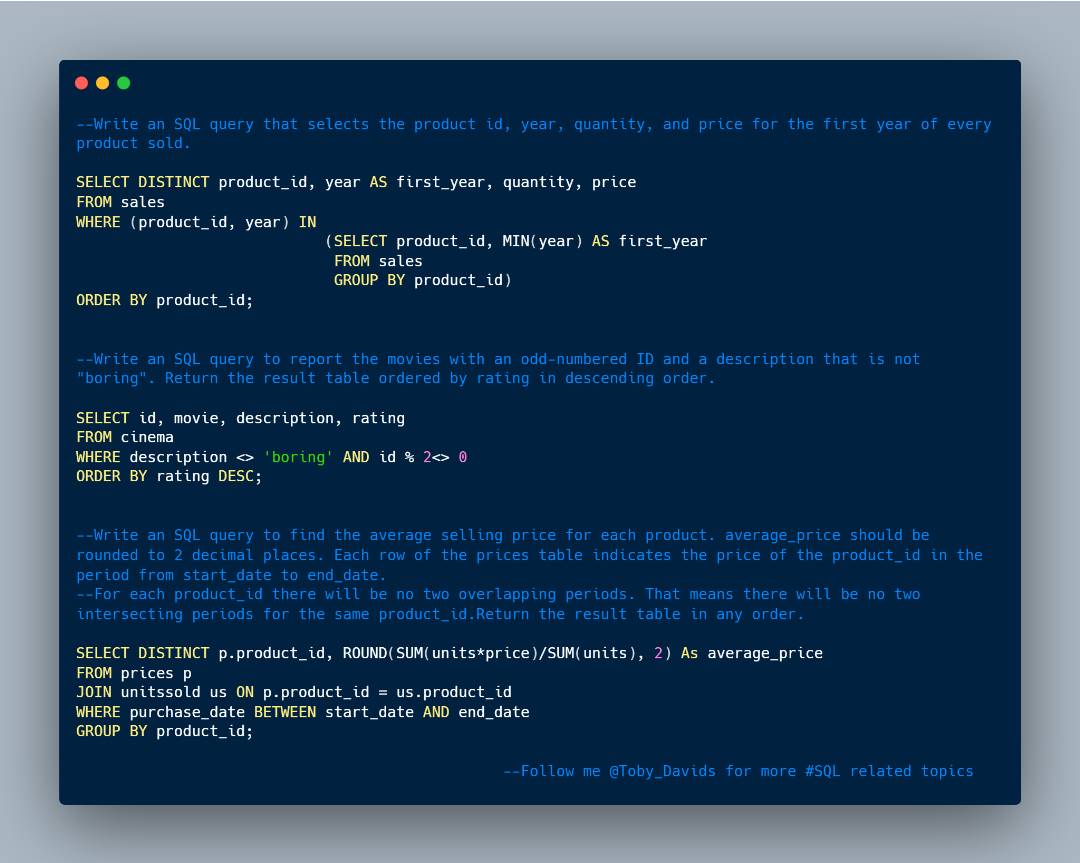#Day3 for Reporting "Crack SQL interview in 50Qs" is hear. Let's rumble
Find the links to the questions here
1. leetcode.com/problems/produ…
2. leetcode.com/problems/not-b…
3. leetcode.com/problems/avera…
#SQL #DATAANALYSIS #Interviews #lowcode
Find the links to the questions here
1. leetcode.com/problems/produ…
2. leetcode.com/problems/not-b…
3. leetcode.com/problems/avera…
#SQL #DATAANALYSIS #Interviews #lowcode
https://twitter.com/Toby_Davids/status/1665857292162547715

Let's break down each code
1. The ending part to the question is where the major conditional logic lies. We were told to return the needed columns, and price for the first year of every product sold. Since we do not have distinct column showing min years for each product,
1. The ending part to the question is where the major conditional logic lies. We were told to return the needed columns, and price for the first year of every product sold. Since we do not have distinct column showing min years for each product,
We have to create that with a subquery in the Where clause. We are concerned about the first year of every product sold, so we aggregate the min years for each product. After doing that, we tell SQL to return the prices of products, the year, and qty when the product was first..
Sold(i.e first year).
2. This is pretty straight forward. We applied the modulus operandi for the IDs, to return movies with an odd number. Hence the need for this-(id%2 <> 0). We also want those movies that aren't boring, hence the not equals to operator was used
2. This is pretty straight forward. We applied the modulus operandi for the IDs, to return movies with an odd number. Hence the need for this-(id%2 <> 0). We also want those movies that aren't boring, hence the not equals to operator was used
3. This was a bit tricky. This was due to this part of the conditions we were given (SQL will always make you read btw the lines). Wahala.. Dem wan use English finish me 

Just look at this part - "Each row of the prices indicate the product_id price. For each product_id,there'll be no two overlapping periods".
To put it in lame man terms. What they want from us is to ensure that we show that for each product sold oo, the time(purchase_date)..
To put it in lame man terms. What they want from us is to ensure that we show that for each product sold oo, the time(purchase_date)..
.. it was purchased must fall in between the start date and End date that of when each unique prices were set for those products. *I just hope I'm not overcomplicating things for you rn*
To make it make further sense ehn. Coca-cola bottling company changed their prices for coke a few times. In Jan, it was $3. In Feb it was $2.5. Hence the Filtering clause we included. If we don't do this, we will be giving the prices for a product at a time to another period.
Every other part of the query just helps us to aggregate the avg prices for each product sold. Make sense, eh?
Kindly let me know your thoughts. Thank you for staying with me. Merci beaucoup 💛
#SQL #DataAnalytics #Jobs
#SQL #DataAnalytics #Jobs
• • •
Missing some Tweet in this thread? You can try to
force a refresh

 Read on Twitter
Read on Twitter






